Places to visit (Places to see in Jaipur)
Jaipur has a number of forts and monuments like Hawa Mahal, Amber Fort, Jaigarh Fort, Nahargarh Fort, City Palace, Jantar Mantar, Jal Mahal, Rambagh Palace, Central Museum, (Albert Hall Museum). There are also many famous temples in Jaipur include Govind Dev Ji Temple, Galtaji, Birla Temple (also known as Lakshmi Narayan Mandir), Garh Ganesh Temple, Shila Devi Temple in Amber, Chamtkareshwer Mahadev, Panchayati Hall,Radha Govind Ji Temple. There are beautiful gardens and parks. Prominent among them are Ram Niwas Garden, Sisodia Rani Garden and Palace, Vidyadhar Garden, Kanak Vrindavan, Central Park, Jawahar Circle Garden, Technology Park in Mansarover, Vidyadhar ka Bagh in Goner. Other places of interest include Chand Baori (stepwell), Chokhi Dhani (a village resort) and Kathputhli slum a Jaipur slum.
The City Palace (The City Palace of Jaipur)
The City Palace is a historic landmark. The carved arches are supported by grey-white marble columns 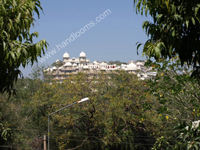 studded with floral motifs in gold and coloured stones. Two elephants carved in marble guard the entrance. The palace interior houses a Museum containing select collection of various types of Rajasthani dresses, a fascinating armory of Mughal and Rajput weapons; swords of all shapes and sizes, with chased handles, some of them inlaid, enameled, encrusted with jewels and encased in bold and magnificent scabbards. It is an art gallery with a fine collection of paintings, carpets, royal paraphernalia and rare astronomical works in Arabic, Persian, Latin and Sanskrit, acquired by Sawai Jai Singh-II for his study of planets and their movements.
studded with floral motifs in gold and coloured stones. Two elephants carved in marble guard the entrance. The palace interior houses a Museum containing select collection of various types of Rajasthani dresses, a fascinating armory of Mughal and Rajput weapons; swords of all shapes and sizes, with chased handles, some of them inlaid, enameled, encrusted with jewels and encased in bold and magnificent scabbards. It is an art gallery with a fine collection of paintings, carpets, royal paraphernalia and rare astronomical works in Arabic, Persian, Latin and Sanskrit, acquired by Sawai Jai Singh-II for his study of planets and their movements.
Jantar Mantar (Jaipur Jantar Mantar – World Heritage site)
Jantar mantar is one of Maharaja Sawai Jai Singh's five remarkable observatories constructed with stone 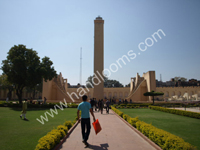 and marble. Its complex instruments whose settings and shapes are precisely and scientifically designed represent the high points of Medieval Indian astronomy. The Ram Yantras used for gauging altitudes are unique in their isolation. This is the largest of the five observatories founded by Sawai Jai Singh-II in various parts of the country. Major Yantras or instruments that you can watch moving clockwise are: Small 'Samrat', 'Dhruva', 'Narivalya', The Observer's Seat, Small 'Kranti Raj' 'Unnathamsa', 'Disha', 'Dakshina', Large 'Samrat', 'Rashivalayas', 'Jai Prakash', Small 'Ram', Large 'Ram Yantra', 'Diganta', Large 'Kranti'. Jantar Mantar has been listed in UNESCO world heritage sites.
and marble. Its complex instruments whose settings and shapes are precisely and scientifically designed represent the high points of Medieval Indian astronomy. The Ram Yantras used for gauging altitudes are unique in their isolation. This is the largest of the five observatories founded by Sawai Jai Singh-II in various parts of the country. Major Yantras or instruments that you can watch moving clockwise are: Small 'Samrat', 'Dhruva', 'Narivalya', The Observer's Seat, Small 'Kranti Raj' 'Unnathamsa', 'Disha', 'Dakshina', Large 'Samrat', 'Rashivalayas', 'Jai Prakash', Small 'Ram', Large 'Ram Yantra', 'Diganta', Large 'Kranti'. Jantar Mantar has been listed in UNESCO world heritage sites.
Hawa Mahal (Jaipur Hawa Mahal)
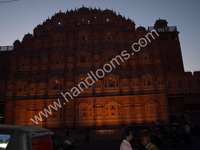 This is built by the poet king Sawai Pratap Singh, the Hawa Mahal is the most strikingly designed monument in Jaipur. What is seen from the Sireh Deorhi Bazaar is the five story high backside of the complex. It was conceived to provide adequate vantage position behind delicate stone carved jali screens to the palace women for watching the royal processions passing through the bazaar below. It can be said that Jaipur is known for Hawa Mahal which is in the heart of Pink city.
This is built by the poet king Sawai Pratap Singh, the Hawa Mahal is the most strikingly designed monument in Jaipur. What is seen from the Sireh Deorhi Bazaar is the five story high backside of the complex. It was conceived to provide adequate vantage position behind delicate stone carved jali screens to the palace women for watching the royal processions passing through the bazaar below. It can be said that Jaipur is known for Hawa Mahal which is in the heart of Pink city.
Amer Fort or Amber Fort (Jaipur Amer / Amber Fort)
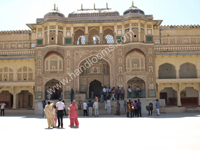 Before Jaipur was built, Amer served as the capital as Kachhwaha rulers of the old state of Dhundhar.
Before Jaipur was built, Amer served as the capital as Kachhwaha rulers of the old state of Dhundhar. 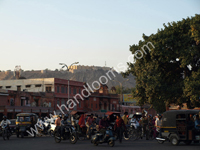 Amer Fort is the complex of palaces, halls, pavilions, gardens and temples, which were built by Raja Man Singh, Mirza Raja Jai Singh and Sawai Jai Singh over a period of about two centuries. The palace complex rising from the placid waters of the Maota Lake is approached through a steep path, now often traversed by tourists on elephant-back, to Singh palace and Jaleb Chowk. Two flights of stairs rise from one end to the chowk, one leading to the elegant temple of Shila Mata and other to the palace complex. The image of the Mother Goddess worshipped with reverence by thousands of devotees every day was brought from Jessore in East Bengal (now in Bangladesh) by raja Man Singh and installed here. The front courtyard of the palace complex is dominated by the spectacular pillared hall of the Diwan-e-Aam and the double storyed painted gateway Ganesh Pole. Beyond the corridors and galleries on the either side of a small elegant Charbagh style garden are Sukh Niwas to its right and Jas Mandir to its left. The Jas Mandir in the upper floor combines the finest elements of Mughal architecture and interior decoration in a Rajput setting with intricately carved jali screens, delicate mirror and stucco works and painted and carved dadoes. The older and simpler structures at the far end were built by Raja Man Singh in the later year of the 16th century. The well proportioned Mohan Bari or Kesar Kyari in the centre of the Mootha Lake and the Dilaram Bagh at its north end provide a spectacular view from the palaces above.
Amer Fort is the complex of palaces, halls, pavilions, gardens and temples, which were built by Raja Man Singh, Mirza Raja Jai Singh and Sawai Jai Singh over a period of about two centuries. The palace complex rising from the placid waters of the Maota Lake is approached through a steep path, now often traversed by tourists on elephant-back, to Singh palace and Jaleb Chowk. Two flights of stairs rise from one end to the chowk, one leading to the elegant temple of Shila Mata and other to the palace complex. The image of the Mother Goddess worshipped with reverence by thousands of devotees every day was brought from Jessore in East Bengal (now in Bangladesh) by raja Man Singh and installed here. The front courtyard of the palace complex is dominated by the spectacular pillared hall of the Diwan-e-Aam and the double storyed painted gateway Ganesh Pole. Beyond the corridors and galleries on the either side of a small elegant Charbagh style garden are Sukh Niwas to its right and Jas Mandir to its left. The Jas Mandir in the upper floor combines the finest elements of Mughal architecture and interior decoration in a Rajput setting with intricately carved jali screens, delicate mirror and stucco works and painted and carved dadoes. The older and simpler structures at the far end were built by Raja Man Singh in the later year of the 16th century. The well proportioned Mohan Bari or Kesar Kyari in the centre of the Mootha Lake and the Dilaram Bagh at its north end provide a spectacular view from the palaces above.
Jaipur
History (History of Jaipur)
Pink City

